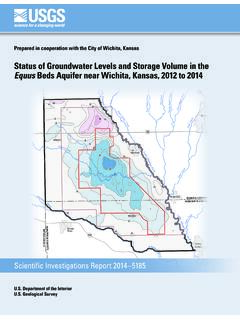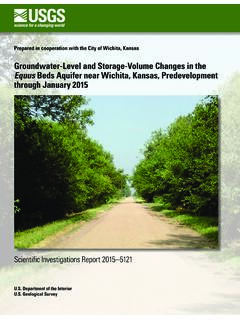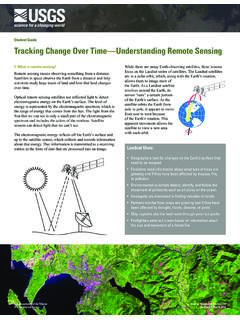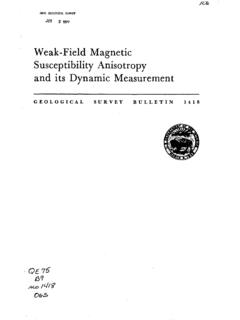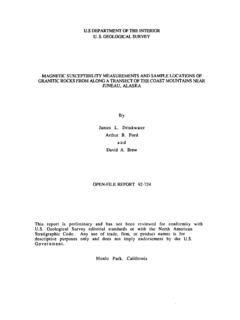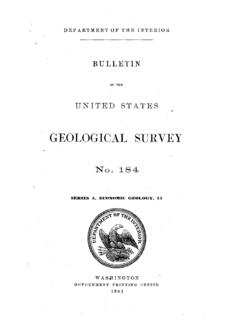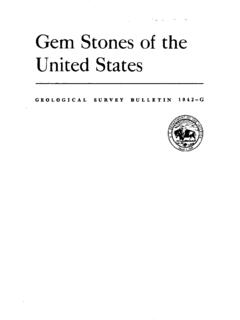Transcription of BIOAVAILABILITY OF METALS INTRODUCTION
1 BIOAVAILABILITY OF METALS . by David A. John and Joel S. Leventhal INTRODUCTION . The fate of various METALS , including chromium, nickel, copper, manganese, mercury, cadmium, and lead, and metalloids, including arsenic, antimony, and selenium, in the natural environment is of great concern (Adriano, 1986;. 1992), particularly near former mine sites, dumps, tailing piles, and impoundments, but also in urban areas and industrial centers. Soil, sediment, water, and organic materials in these areas may contain higher than average abundances of these elements, in some cases due to past mining and (or) industrial activity, which may cause the formation of the more bioavailable forms of these elements.
2 In order to put elemental abundances in perspective, data from lands and watersheds adjacent to these sites must be obtained and background values, often controlled by the bedrock geology and (or) water-rock interaction, must be defined. In order to estimate effects and potential risks associated with elevated elemental concentrations that result from natural weathering of mineral deposits or from mining activities, the fraction of total elemental abundances in water, sediment, and soil that are bioavailable must be identified. BIOAVAILABILITY is the proportion of total METALS that are available for incorporation into biota (bioaccumulation).
3 Total metal concentrations do not necessarily correspond with metal BIOAVAILABILITY . For example, sulfide minerals may be encapsulated in quartz or other chemically inert minerals, and despite high total concentrations of METALS in sediment and soil containing these minerals, METALS are not readily available for incorporation in the biota; associated environmental effects may be low (Davis and others, 1994). Consequently, overall environmental impact caused by mining these rocks may be much less than mining another type of mineral deposit that contains more reactive minerals in lower abundance. In aquatic environments where chemically reducing conditions may prevail, METALS from mining activities may be associated with sulfide minerals.
4 These sulfide minerals are present either in the ore deposit or formed by bacterial reduction of the sulfate in oxidized tailings. Most metal sulfide minerals are quite immobile, as long as they remain in a chemically reducing environment, and they may have little impact on biota despite anomalous metal concentrations. BIOAVAILABILITY . METALS of major interest in BIOAVAILABILITY studies , as listed by the Environmental Protection Agency (EPA), are Al, As, Be, Cd, Cr, Cu, Hg, Ni, Pb, Se, and Sb (McKinney and Rogers, 1992). Other METALS that are presently of lesser interest to the EPA are Ag, Ba, Co, Mn, Mo, Na, Tl, V, and Zn.
5 These METALS were selected because of their potential for human exposure and increased health risk. Some highlights concerning the BIOAVAILABILITY of As, Cd, Cu, Hg, Mo, Pb, Se, and Zn in water and (or) sediment are discussed in the section below entitled "Specific METALS of interest.". METALS can be dispersed in soil, water, and air. Geoscientists are mainly concerned with METALS dispersed in soil and sediment, dissolved in ground and surface water, suspended as particles in surface water, and in pore fluid in sediment (fig. 1). In addition, METALS can be dispersed into the atmosphere, by natural geochemical cycling and by other anthropogenic processes (such as smelting and burning leaded gasoline and coal) and by microbial activities.
6 These metal fluxes must be considered in overall metal BIOAVAILABILITY studies . Bioaccumulation of METALS by biota in surface water and by plants and animals in terrestrial environments can adversely affect humans. In surface and ground water, sediment and air, BIOAVAILABILITY is a complex function of many factors including total concentration and speciation (physical-chemical forms) of METALS , mineralogy, pH, redox potential, temperature, total organic content (both particulate and dissolved fractions), and suspended particulate content, as well as volume of water, water velocity, and duration of water availability, particularly in arid and semi-arid environments.
7 In addition, wind transport and removal from the atmosphere by rainfall (frequency is more important than amount) must be considered. Many of these factors vary seasonally and temporally, and most factors are interrelated. Consequently, changing one factor may affect several others. In addition, generally poorly understood biological factors seem to strongly influence bioaccumulation of METALS and severely inhibit prediction of metal BIOAVAILABILITY (Luoma, 1989). Some of the major controls on the BIOAVAILABILITY of METALS in surface water and soil and data concerning potentially hazardous METALS are described below.
8 In order to understand BIOAVAILABILITY , plant materials and selective chemical leaches of soil must be analyzed and the results compared. Elemental suites for which analyses are performed and the type of selective leaches utilized must be tailored to bedrock and soil types, and to suspected anthropogenic inputs. Soil pH, organic matter, 10. Figure 1. Interrelationships of man, METALS , and the environment. Modified from Salomons and Forstner (1988). Figure 2. The chemical forms of METALS in solid phases. Modified from Gunn and others (1988). and sulfur and carbonate contents should be determined to enable accurate assessment of elemental reservoirs, mobility, and BIOAVAILABILITY .
9 Additional work on mineralogical residences of METALS is also important because METALS can be associated with several sites (fig. 2). Soil scientists involved in agriculture havebeen studying the chemistry of nutrient elements in soil for more than 100 years. Soil testing methods are used to determine sixteen essential elements for plant growth, but nitrogen, phosphorous, and potassium, along with pH and salinity are the most often measured properties (Peck and Soltanpour, 1990). Physical-chemical aspects of nutrient availability are discussed by Corey (1990) and soil testing correlations are reviewed by Dahnke and Olson (1990).
10 FACTORS THAT INFLUENCE BIOAVAILABILITY IN SOIL. Plant uptake of trace elements is generally the first step of their entry into the agricultural food chain. Plant uptake is dependent on (1) movement of elements from the soil to the plant root, (2) elements crossing the membrane of epidermal cells of the root, (3) transport of elements from the epidermal cells to the xylem, in which a solution of 11. Table 1. Relative mobility and availability of trace METALS (modified from Salomons, 1995). Metal species and association Mobility Exchangeable (dissolved) cations High. Changes in major cationic composition ( estuarine environment).
